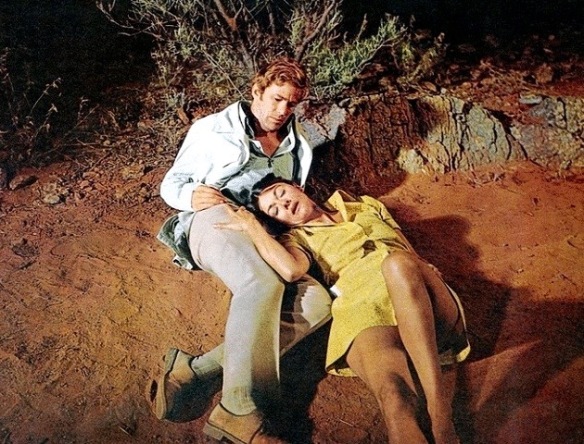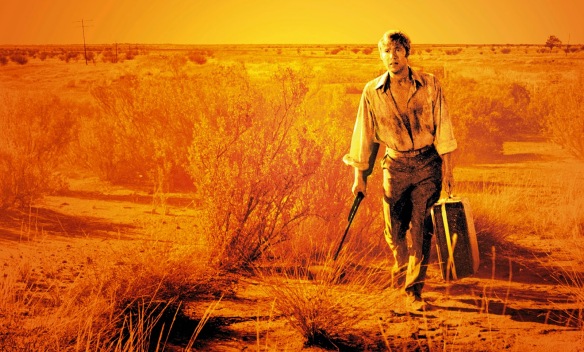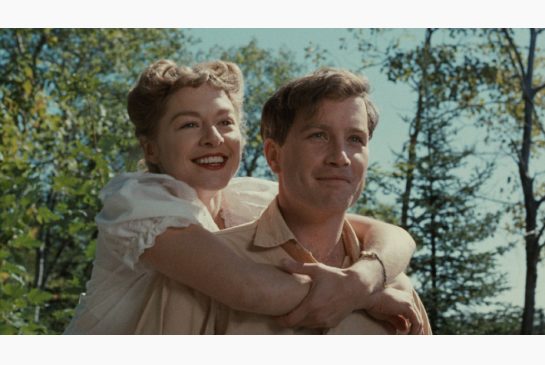Retitled and released as Outback in the U.S. and Great Britain in 1971, Ted Kotcheff’s Wake in Fright was barely noticed by American critics and moviegoers and quickly vanished from screens. What attention it did receive in England at the time was mostly critical of the film’s negative depiction of the Australian Outback region and its inhabitants. And despite the fact that it was a huge critical success at Cannes and was nominated for the Golden Palm, the film went missing soon after and until recently was considered a lost film.
 If you saw the brash, exhilarating survey of Australian exploitation films, Not Quite Hollywood: The Wild, Untold Story of Ozploitation! (2008), you would have seen a bizarre, over-the-top clip from Wake in Fright where Peter Whittle (a well known middleweight Aussie boxer) engages in hand to hand combat with an angry, wounded kangaroo. Despite the extreme nature of the clip though, Wake in Fright is no exploitation film. And it’s no art house darling either. It’s a blunt, powerful and disturbing emotional experience with a surreal visual quality and probably the crowning achievement of Ted Kotcheff’s career.
If you saw the brash, exhilarating survey of Australian exploitation films, Not Quite Hollywood: The Wild, Untold Story of Ozploitation! (2008), you would have seen a bizarre, over-the-top clip from Wake in Fright where Peter Whittle (a well known middleweight Aussie boxer) engages in hand to hand combat with an angry, wounded kangaroo. Despite the extreme nature of the clip though, Wake in Fright is no exploitation film. And it’s no art house darling either. It’s a blunt, powerful and disturbing emotional experience with a surreal visual quality and probably the crowning achievement of Ted Kotcheff’s career.
The Canadian-born director is best known for The Apprenticeship of Duddy Kravitz (1974), a coming-of-age, character driven tale that helped launch Richard Dreyfuss as a leading man, and a string of commercial hits – Fun With Dick and Jane (1977), North Dallas Forty (1979), First Blood (1982) and Uncommon Valor (1983). He also enjoyed some critical acclaim and another Golden Palm nomination at Cannes for Joshua Then and Now (1985) starring James Woods as an unorthodox writer in a story with a Jewish working class background similar to Duddy Kravitzv (both were based on novels by Mordecai Richler).
He’s also had his share of flops (Billy Two Hats, Switching Channels, Winter People) and is equally capable of such lowbrow fare as Weekend at Bernie’s (1989). In all, Kotcheff is a talented, above average film and TV director but probably not a major figure in contemporary cinema….until you consider Wake in Fright. Just as some writers stake their reputations on one great novel and a lot of lesser works, so is the case with some filmmakers who have scored a major cinema triumph and never directed anything else to equal or surpass it. I suspect this is the case with Kotcheff but even if Wake in Fright was the only film he ever made, it would be cause enough to guarantee him a permanent place in the annals of film history.
The original title Wake in Fright is much more appropriate than Outback because this is truly a journey into darkness despite taking place, for the most part, under a blazing, unforgiving sun. It brilliantly creates a nightmare state with its own twisted logic and rules. It is an adult horror film in the best sense of the term; one that explores the impact of a strange environment and culture on one’s identity and how circumstances can lead one to discover a dark side of himself that he never knew existed.
The painterly cinematography of Brian West evokes an inferno-like landscape through a palette of burnt sienna, oranges, yellows and browns. Occasionally he will use a primary color accent such as a red lamp or a blue beer bottle to stand out amid the muted surroundings. Several of the interior scenes are highlighted by a sickly green lighting scheme and dust is everywhere (Kotcheff admitted going overboard on the use of Fuller’s Earth, a favorite of art directors). Adding to the unsettling mood is John Scott’s subtle music score which mirrors the increasingly dark direction of the narrative.
Based on the novel by Kenneth Cook, a popular and highly prolific Australian journalist/TV personality/screenwriter, Wake in Fright was a bestseller in its own country and the storyline and setting was inspired by Cook’s early years of working as a radio journalist for the Australian Broadcasting Company while stationed in Broken Hill, a remote mining town in South Wales, Australia. Reputedly Cook was a larger-than-life personality whom some critics compared to Ernest Hemingway in terms of his machismo if not literary style. And Broken Hill, which he once referred to as “unmitigated boil of horror,” served him well as a metaphor for the rowdy, male-dominated society of the Outback.

Hunting and drinking are the main activities in the Outback as depicted by director Ted Kotcheff in the bleak, psychological drama Wake in Fright (1971)
The story opens with a stunning 360-degree camera pan that reveals the vast emptiness of a dusty, sun-baked desert wasteland before coming to rest on a railroad trestle that runs between two shacks, one of them a one-room schoolhouse. Inside a mixture of elementary, middle and high school students wait to be dismissed for the Christmas holidays by their schoolteacher, John Grant (Gary Bond). After the children scurry off to their homes, Grant walks across the tracks to his boarding house on the other side, packs a few things in a suitcase and has some drinks and a smoke with his landlord (John Meillon) before departing for Sydney where he will spend his vacation. But Grant will never reach Sydney. Instead he gets stranded in Bundanyabba, referred to by locals as “The Yabba,” after losing all of his money in an illegal gambling den playing “Two-Up,” a double coin toss game.
From this point on, Grant finds himself completely at the mercy of strangers whose aggressive hospitality he can’t refuse and that means matching them drink for drink in the long hours that run into the dawn. Days become weeks as Grant sinks into an alcoholic haze and chance encounters that take him deeper and deeper into the Outback, culminating in a nighttime kangaroo hunt which becomes a test of his manhood. The horror doesn’t end there though.  Like Joseph Conrad’s Heart of Darkness, Wake in Fright explores the fine line between civilized behavior and savagery and the effect is not life-affirming. A more brutal, primeval vision of a closed male society, remote and isolated, is hard to imagine. Women barely exist in this universe. In fact, with the exception of the schoolchildren at the beginning, there are only three female characters in the movie – a detached hotel clerk, a barmaid and the lost, defeated wife of one of the men who befriends Grant. They are all practically invisible in this manly world of blood sports, drinking, brawling and gambling. It’s a place where no moral compass exists or room for self-reflection.
Like Joseph Conrad’s Heart of Darkness, Wake in Fright explores the fine line between civilized behavior and savagery and the effect is not life-affirming. A more brutal, primeval vision of a closed male society, remote and isolated, is hard to imagine. Women barely exist in this universe. In fact, with the exception of the schoolchildren at the beginning, there are only three female characters in the movie – a detached hotel clerk, a barmaid and the lost, defeated wife of one of the men who befriends Grant. They are all practically invisible in this manly world of blood sports, drinking, brawling and gambling. It’s a place where no moral compass exists or room for self-reflection.
In Cook’s view, the Outback is a place that is vehemently anti-intellectual and anti-feeling; everything is dulled by alcohol and only the baser instincts are intact. The macho behavior on display is, in fact, exaggerated due to the absence of women and Kotcheff, in the DVD commentary, states that men outnumber women three to one in the Outback. He also noted that the suicide rate for women in the region is five times the national average, an understandable fact when you consider the harsh conditions of the region.

Donald Pleasence takes his pleasure in the arid, dusty Outback region of Australia in Wake in Fright (1971)
Part of the film’s power can be attributed to the stellar cast and top billed Donald Pleasence gives what I feel might be his greatest performance as Doc Tydon. Though he is essentially a supporting character, he serves as a prophetic warning to Grant. This debased human being was once a functioning member of society like the schoolteacher but the Outback “freed” him to become himself. “I’m a doctor of medicine and a tramp by temperment and also an alcoholic,” Tydon admits almost gleefully to Grant.
Chips Rafferty, one of the most famous and iconic actors in Australian cinema, is equally memorable as Jock Crawford, a formidable community leader in the “Yabba” who takes Grant on a tour of the local attractions. Crawford’s subtle contempt for this city bred outsider is hard to ignore and adds a sinister tension to their scenes together (this was Rafferty’s last film role; he died a few months after filming).

Local native Chips Rafferty (left) has some advice for visitor Gary Bond in Wake in Fright aka Outback (1971)
Sylvia Kay (Kotcheff’s wife in real life) makes the most of her brief scenes and is alternately pitiful and poignant in the bleak sequence where she attempts to seduce Grant in the desert while her husband and his blokes get roaring drunk. She lies down on the hard ground, mute but longing for sex and human contact and Grant’s drunken reaction – he vomits while trying to penetrate her – is typical of the film’s underlying sense of despair.

A sexual encounter between Gary Bond and Sylvia Kay becomes a cry of despair in Wake in Fright (1971)
Wake in Fright also features Jack Thompson in his feature film debut as a testosterone-driven hunter; the actor would go on to become one of his country’s top stars appearing in such critically acclaimed films as Sunday Too Far Away (1975), The Chant of Jimmy Blacksmith (1978) and Breaker Morant (1980).
Last but not least is Gary Bond as the ill-fated John Grant. Bond is not that well known outside of his native England where he was a popular and prolific actor on television series like The Main Chance and BBC Play of the Month. He worked on American TV series as well but his film work was minimal with small roles in Zulu (1964) and Anne of the Thousand Days (1969). Wake in Fright remains his only major film role (he died in 1994 after a long battle with AIDS). Bond is perfectly cast as the repressed, weak-willed central character and bears some physical similarities to Richard Chamberlain. If there is a flaw in the film, it is the fact that John Grant remains a cipher from beginning to end. Despite everything that happens to him, you don’t know at the fadeout whether he has become a numb shell of a man or simply blotted out his horrendous ordeal and returned to his boring life of servitude to the state.
I was surprised to learn in the DVD audio commentary for Wake in Fright that Dirk Bogarde had originally been cast in the film with Joseph Losey slated to direct. Now THAT would have been an entirely different film. It didn’t work out of course and there were later rumors that James Mason was going to be cast in the role of Doc Tydon, the part that Pleasence played.
One final word of caution about Wake in Fright. It does contain some brutal and hard to watch animal violence in the final third during the kangaroo hunt. Although Kotcheff stated that he abhors cruelty to animals and didn’t harm any during the filming, the horrific nighttime hunt sequence incorporated real footage from Australian hunters as they stalked and killed kangaroos with high-powered rifles. Of course, there are other things to shock and offend in Wake in Fright such as male rape, the killing and eating of an uncooked rabbit and a rifle to the head suicide attempt. In fact, fifteen minutes of objectionable content was reportedly removed for the U.S. release version but this is the original edit and it’s not likely to become a popular chick flick.

Chips Rafferty (left) and Gary Bond in a scene from Wake in Fright aka Outback (1971), directed by Ted Kotcheff
When Wake in Fright opened as Outback in the U.S., it did garner some critical praise but not enough to have any impact on the ticket sales. Roger Greenspan of The New York Times wrote that the movie exuded “a sense of general foreboding that crystalizes often enough into particular terror and that is not quite like anything else I can remember feeling at the movies….The crisp snap of a pull-tab aluminum beer can may never replace the creaking door as a clue to horror, but in “Outback” it makes a reasonable try. There are, of course, more spectacular invocations, such as a pair of kangaroo hunts—one by day, one by night…But scarier for me is a scene in one of the city’s great sprawling saloons, a moment of hushed, terrifying solemnity when in a kind of lunatic praise of long-departed soldiers, sailors and airmen, the drinkers are admonished over a spectral loudspeaker, “Lest We Forget!”
Pauline Kael of The New Yorker wrote that Kotcheff and screenwriter Evan Jones approached their subject “as if they were cultural anthropologists examining a newly developed form of primitive life – the primitivism of the master race. Maybe Kotcheff didn’t dare to expand this vision at the expense of the plot line, but he got on to something bigger than the plot. And, even though the movie retreats into its narrow frame, you come out with a sense of epic horror.”
Thanks to the relentless efforts of Anthony Buckley, the film’s editor, and the preservation efforts of the National Film & Sound Archive of Australia, Wake in Fright was restored to its original cut in 2009 on DVD in the PAL format (you need an all-region DVD player to view it) with a host of extra features including an audio commentary by Kotcheff and Buckley. In 2013 Drafthouse Films released a Blu-Ray/DVD combo of the film for the U.S. market and it includes the same extra features from the NFSA release. Since then, Wake in Fright has enjoyed a rapidly growing critical revival. The film has gained additional exposure and acclaim from various film festival screenings like Telluride in the past few years as well as the avid support of such fans as Martin Scorsese who first saw it at Cannes in 1971. The director even admits that the film looks even better now due to current film preservation technology than it did in its original theatrical prints.
Scorsese also makes a case for Wake in Fright as a seminal film that helped launch the Australian cinema renaissance of the ‘70s, which is debatable but certainly worth considering. 1971 was also the same year of Nicholas Roeg’s Walkabout, another film set in the Outback. Curiously, both films were made by non-Australians, both outsiders to the burgeoning film industry at the time.  You could also make a case for 1970 as the real beginning of the Australian New Wave with Tony Richardson’s Ned Kelly and Phillip Leacock’s Adam’s Woman leading the pack. Regardless of the mediocre boxoffice performance of these earlier productions, they did draw attention to Australia as a promising film location and obviously encouraged the country’s filmmakers to make their own feature films. By the late seventies such major talents as Peter Weir, Bruce Beresford, Gillian Armstrong, Fred Schepisi, Phillip Noyce and George Miller had emerged at the forefront of this new film movement. But I can’t help but think that Wake in Fright started the brushfire that became a creative firestorm.
You could also make a case for 1970 as the real beginning of the Australian New Wave with Tony Richardson’s Ned Kelly and Phillip Leacock’s Adam’s Woman leading the pack. Regardless of the mediocre boxoffice performance of these earlier productions, they did draw attention to Australia as a promising film location and obviously encouraged the country’s filmmakers to make their own feature films. By the late seventies such major talents as Peter Weir, Bruce Beresford, Gillian Armstrong, Fred Schepisi, Phillip Noyce and George Miller had emerged at the forefront of this new film movement. But I can’t help but think that Wake in Fright started the brushfire that became a creative firestorm.
For more information on the epic restoration saga of Wake in Fright, see the featurette on YouTube or read the DVD liner notes about it on the Umbrella Entertainment release. – http://mumbrella.com.au/forever-young-restoration-and-preservation-987
Other website links of interest:
http://www.dga.org/Craft/VisualHistory/Interviews/Ted-Kotcheff.aspx
https://www.youtube.com/watch?v=le78LmmI6Kc
http://www.independent.co.uk/news/people/obituary-gary-bond-1578043.html
http://www.thewonderfulworldofgarybond.com/profile-of-gary.html

















